Nathan Matsuda
HoloChrome: Polychromatic Illumination for Speckle Reduction in Holographic Near-Eye Displays
Oct 31, 2024Abstract:Holographic displays hold the promise of providing authentic depth cues, resulting in enhanced immersive visual experiences for near-eye applications. However, current holographic displays are hindered by speckle noise, which limits accurate reproduction of color and texture in displayed images. We present HoloChrome, a polychromatic holographic display framework designed to mitigate these limitations. HoloChrome utilizes an ultrafast, wavelength-adjustable laser and a dual-Spatial Light Modulator (SLM) architecture, enabling the multiplexing of a large set of discrete wavelengths across the visible spectrum. By leveraging spatial separation in our dual-SLM setup, we independently manipulate speckle patterns across multiple wavelengths. This novel approach effectively reduces speckle noise through incoherent averaging achieved by wavelength multiplexing. Our method is complementary to existing speckle reduction techniques, offering a new pathway to address this challenge. Furthermore, the use of polychromatic illumination broadens the achievable color gamut compared to traditional three-color primary holographic displays. Our simulations and tabletop experiments validate that HoloChrome significantly reduces speckle noise and expands the color gamut. These advancements enhance the performance of holographic near-eye displays, moving us closer to practical, immersive next-generation visual experiences.
Practical High-Contrast Holography
Oct 25, 2024Abstract:Holographic displays are a promising technology for immersive visual experiences, and their potential for compact form factor makes them a strong candidate for head-mounted displays. However, at the short propagation distances needed for a compact, head-mounted architecture, image contrast is low when using a traditional phase-only spatial light modulator (SLM). Although a complex SLM could restore contrast, these modulators require bulky lenses to optically co-locate the amplitude and phase components, making them poorly suited for a compact head-mounted design. In this work, we introduce a novel architecture to improve contrast: by adding a low resolution amplitude SLM a short distance away from the phase modulator, we demonstrate peak signal-to-noise ratio improvement up to 31 dB in simulation compared to phase-only, even when the amplitude modulator is 60$\times$ lower resolution than its phase counterpart. We analyze the relationship between diffraction angle and amplitude modulator pixel size, and validate the concept with a benchtop experimental prototype. By showing that low resolution modulation is sufficient to improve contrast, we pave the way towards practical high-contrast holography in a compact form factor.
Multisource Holography
Sep 19, 2023

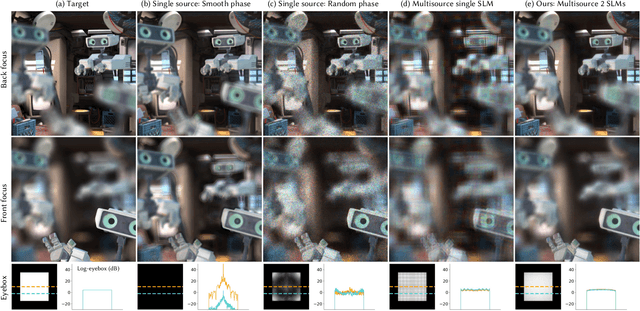

Abstract:Holographic displays promise several benefits including high quality 3D imagery, accurate accommodation cues, and compact form-factors. However, holography relies on coherent illumination which can create undesirable speckle noise in the final image. Although smooth phase holograms can be speckle-free, their non-uniform eyebox makes them impractical, and speckle mitigation with partially coherent sources also reduces resolution. Averaging sequential frames for speckle reduction requires high speed modulators and consumes temporal bandwidth that may be needed elsewhere in the system. In this work, we propose multisource holography, a novel architecture that uses an array of sources to suppress speckle in a single frame without sacrificing resolution. By using two spatial light modulators, arranged sequentially, each source in the array can be controlled almost independently to create a version of the target content with different speckle. Speckle is then suppressed when the contributions from the multiple sources are averaged at the image plane. We introduce an algorithm to calculate multisource holograms, analyze the design space, and demonstrate up to a 10 dB increase in peak signal-to-noise ratio compared to an equivalent single source system. Finally, we validate the concept with a benchtop experimental prototype by producing both 2D images and focal stacks with natural defocus cues.
Stochastic Light Field Holography
Jul 12, 2023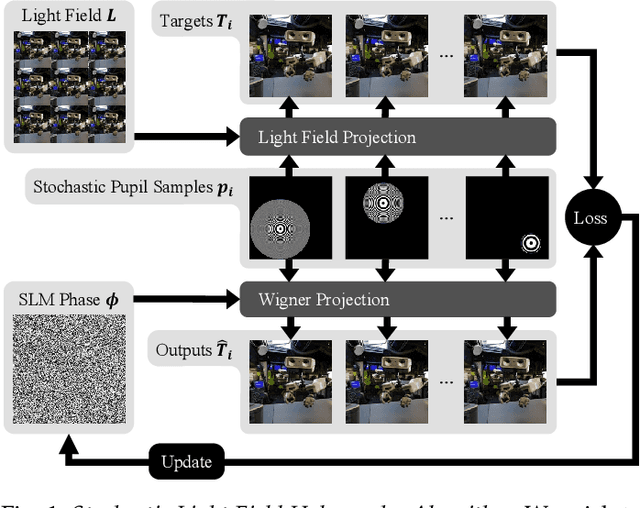


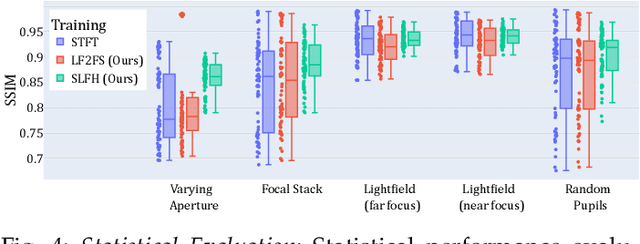
Abstract:The Visual Turing Test is the ultimate goal to evaluate the realism of holographic displays. Previous studies have focused on addressing challenges such as limited \'etendue and image quality over a large focal volume, but they have not investigated the effect of pupil sampling on the viewing experience in full 3D holograms. In this work, we tackle this problem with a novel hologram generation algorithm motivated by matching the projection operators of incoherent Light Field and coherent Wigner Function light transport. To this end, we supervise hologram computation using synthesized photographs, which are rendered on-the-fly using Light Field refocusing from stochastically sampled pupil states during optimization. The proposed method produces holograms with correct parallax and focus cues, which are important for passing the Visual Turing Test. We validate that our approach compares favorably to state-of-the-art CGH algorithms that use Light Field and Focal Stack supervision. Our experiments demonstrate that our algorithm significantly improves the realism of the viewing experience for a variety of different pupil states.
Neural Étendue Expander for Ultra-Wide-Angle High-Fidelity Holographic Display
Sep 16, 2021
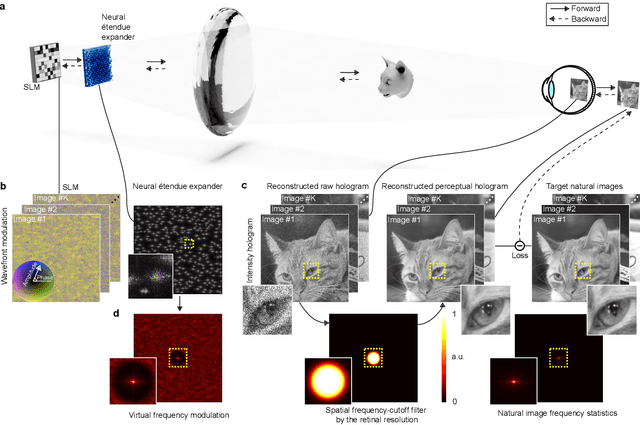
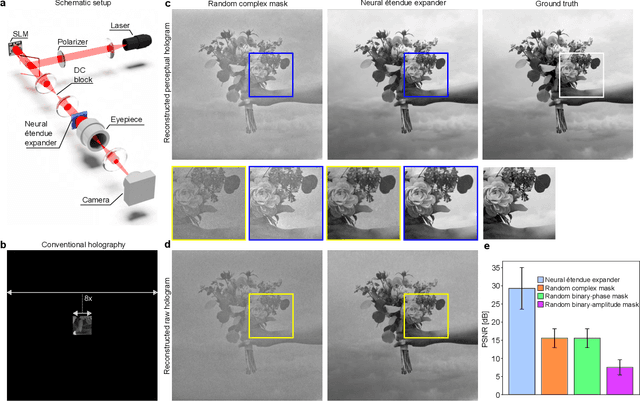
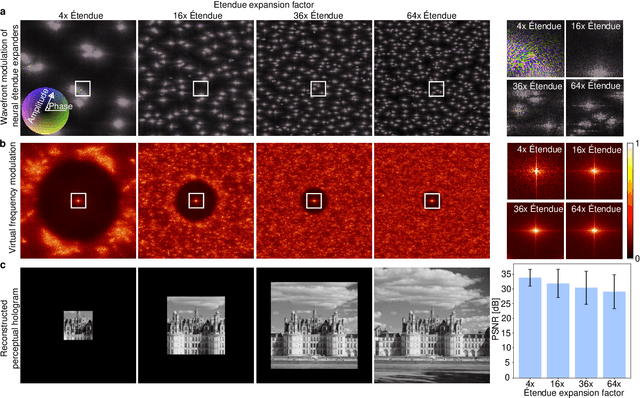
Abstract:Holographic displays can generate light fields by dynamically modulating the wavefront of a coherent beam of light using a spatial light modulator, promising rich virtual and augmented reality applications. However, the limited spatial resolution of existing dynamic spatial light modulators imposes a tight bound on the diffraction angle. As a result, today's holographic displays possess low \'{e}tendue, which is the product of the display area and the maximum solid angle of diffracted light. The low \'{e}tendue forces a sacrifice of either the field of view (FOV) or the display size. In this work, we lift this limitation by presenting neural \'{e}tendue expanders. This new breed of optical elements, which is learned from a natural image dataset, enables higher diffraction angles for ultra-wide FOV while maintaining both a compact form factor and the fidelity of displayed contents to human viewers. With neural \'{e}tendue expanders, we achieve 64$\times$ \'{e}tendue expansion of natural images with reconstruction quality (measured in PSNR) over 29dB on simulated retinal-resolution images. As a result, the proposed approach with expansion factor 64$\times$ enables high-fidelity ultra-wide-angle holographic projection of natural images using an 8K-pixel SLM, resulting in a 18.5 mm eyebox size and 2.18 steradians FOV, covering 85\% of the human stereo FOV.
LiveView: Dynamic Target-Centered MPI for View Synthesis
Jul 11, 2021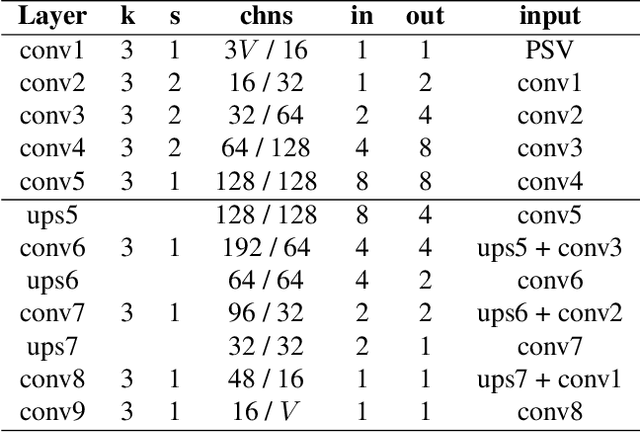
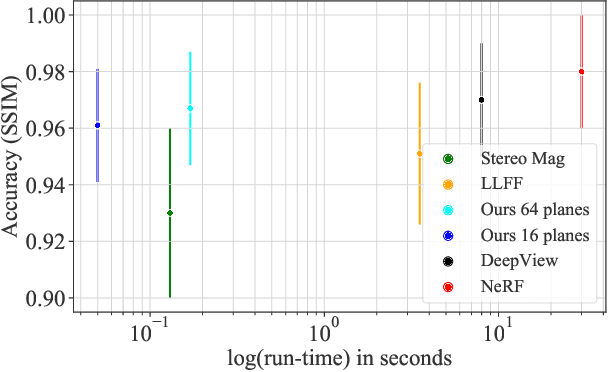

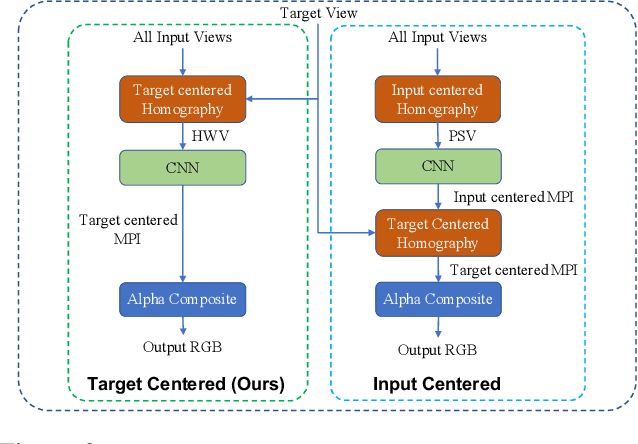
Abstract:Existing Multi-Plane Image (MPI) based view-synthesis methods generate an MPI aligned with the input view using a fixed number of planes in one forward pass. These methods produce fast, high-quality rendering of novel views, but rely on slow and computationally expensive MPI generation methods unsuitable for real-time applications. In addition, most MPI techniques use fixed depth/disparity planes which cannot be modified once the training is complete, hence offering very little flexibility at run-time. We propose LiveView - a novel MPI generation and rendering technique that produces high-quality view synthesis in real-time. Our method can also offer the flexibility to select scene-dependent MPI planes (number of planes and spacing between them) at run-time. LiveView first warps input images to target view (target-centered) and then learns to generate a target view centered MPI, one depth plane at a time (dynamically). The method generates high-quality renderings, while also enabling fast MPI generation and novel view synthesis. As a result, LiveView enables real-time view synthesis applications where an MPI needs to be updated frequently based on a video stream of input views. We demonstrate that LiveView improves the quality of view synthesis while being 70 times faster at run-time compared to state-of-the-art MPI-based methods.
Toward Long Distance, Sub-diffraction Imaging Using Coherent Camera Arrays
Oct 28, 2015



Abstract:In this work, we propose using camera arrays coupled with coherent illumination as an effective method of improving spatial resolution in long distance images by a factor of ten and beyond. Recent advances in ptychography have demonstrated that one can image beyond the diffraction limit of the objective lens in a microscope. We demonstrate a similar imaging system to image beyond the diffraction limit in long range imaging. We emulate a camera array with a single camera attached to an X-Y translation stage. We show that an appropriate phase retrieval based reconstruction algorithm can be used to effectively recover the lost high resolution details from the multiple low resolution acquired images. We analyze the effects of noise, required degree of image overlap, and the effect of increasing synthetic aperture size on the reconstructed image quality. We show that coherent camera arrays have the potential to greatly improve imaging performance. Our simulations show resolution gains of 10x and more are achievable. Furthermore, experimental results from our proof-of-concept systems show resolution gains of 4x-7x for real scenes. Finally, we introduce and analyze in simulation a new strategy to capture macroscopic Fourier Ptychography images in a single snapshot, albeit using a camera array.
 Add to Chrome
Add to Chrome Add to Firefox
Add to Firefox Add to Edge
Add to Edge